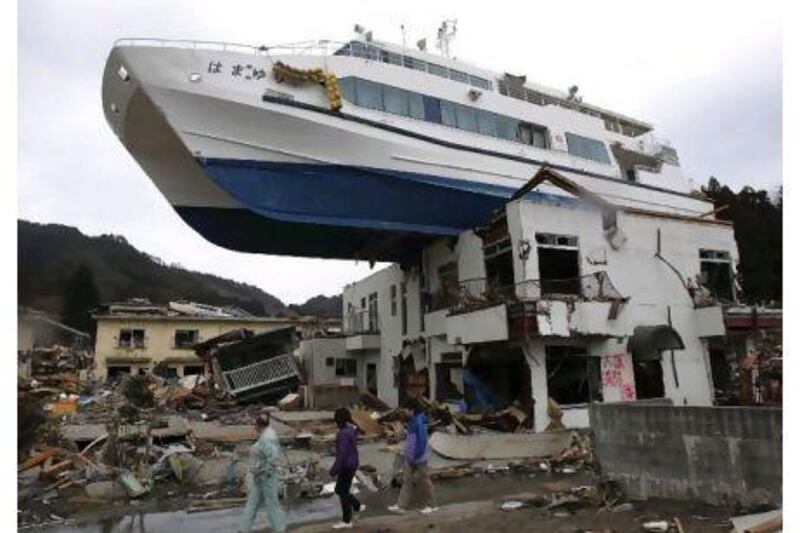Workers reconnected power lines to all six reactor units at Japan's radiation-leaking nuclear plant yesterday, its operator said, marking a significant step in bringing the overheated complex under control.
Growing evidence emerged of contamination around the plant, with further samples of seawater found to contain heavily increased levels of radioactive iodine.
Tokyo Electric Power Company, in finally connecting the lines after days filled with anxiety, warned that much work needed to be done before the electricity could be turned on. Workers are checking all additional equipment for damage to make sure cooling systems can be safely operated, Tokyo Electric said.
It comes after the World Health Organisation this week described the issue of radioactivity in food as being "more serious" than first thought.
In another advance, emergency crews dumped 18 tonnes of seawater into a nearly boiling storage pool holding spent nuclear fuel, cooling it to 50°C, Japan's nuclear safety agency said. Steam, possibly carrying radioactive elements, had been rising for two days from the reactor building, and the move lessens the chances that more radiation will seep into the air.
Together, the power lines and concerted dousing brought authorities closer to ending a nuclear crisis that has complicated the government's response to the 9.0-magnitude earthquake and tsunami that devastated Japan's north-east coast 12 days ago.
The death toll from the earthquake and tsunami has risen to 9,079 with at least 12,465 missing. In Miyagi prefecture alone, estimates have put the total number killed at 15,000. Mass burials of the dead are taking place.
Conditions for many survivors remain difficult, with supplies of food, water and fuel running low in many parts of north-east Japan. More than 350,000 people are still living in evacuation centres, although temporary housing is now being built to accommodate some of them.
Power rationing has been restarted in parts of the country amid energy shortages caused by the loss of power from nuclear plants.
In a sign that north-east Japan was far from a return to normality yesterday, seawater collected eight kilometres south of the plant contained levels of radioactive iodine 80.3 times the "standard level", according to the Kyodo news agency, while 16km from the plant levels had increased 16.4-fold.
Sampling near the plant on Monday found radioactive iodine amounts in seawater 126.7 times the recommended maximum, while quantities of radioactive caesium, a greater hazard, were 24.8 times the recommended limit.
On Monday, the International Atomic Energy Agency said radiation levels on land about 20km from the plant were 1,600 times normal.
Despite continued concern about radiation leaks, the Japanese authorities have insisted there is no need to expand the evacuation areas around the plant.
In total 170,000 people have been evacuated from within a 20km radius of the plant, while those living between 20km and 30km are advised to stay indoors and turn off ventilation systems.
"There doesn't appear to be a continuous major release of radioactivity like we saw in Chernobyl. Until these things change, the Japanese authorities appear to be doing the right thing," Laurence Williams, a professor of nuclear safety at the University of Central Lancashire in the United Kingdom, said by telephone.
Several countries, including the United States and United Kingdom, have recommended their nationals stay at least 80km from the plant.
The Japanese authorities have stopped the sale of milk and certain vegetables produced from areas close to the plant, although officials insist food produced in other parts of the country remains safe. Some residents have been told not to drink tap water because it contains radioactive iodine.
Several countries, including the Philippines, China and South Korea, are screening food imports from Japan for radioactivity. South Korea's Yonhap news agency yesterday reported that imports of Japanese seafood had slumped significantly as a result of the crisis.
The Japanese industry minister, Banri Kaieda, yesterday apologised following allegations he had threatened to "punish" firefighters if they refused to take part in dousing operations.
The governor of Tokyo, Shintaro Ishihara, earlier protested to the prime minister, Naoto Kan, over the alleged forcing of personnel to carry out the potentially hazardous work.
At a press conference yesterday, Mr Kaieda, who is second in command of a task force set up to manage the response to the crisis, said he apologised "if my remarks offended the firefighters".
Norio Tsuzumi, an executive vice president of Tokyo Electric Power Company, which operates the Fukushima plant, yesterday apologised to residents from the area surrounding the plant who have been forced to flee to evacuation centres.
"We are sorry to have caused you too much trouble," he said.
* With additional reporting by the Associated Press






